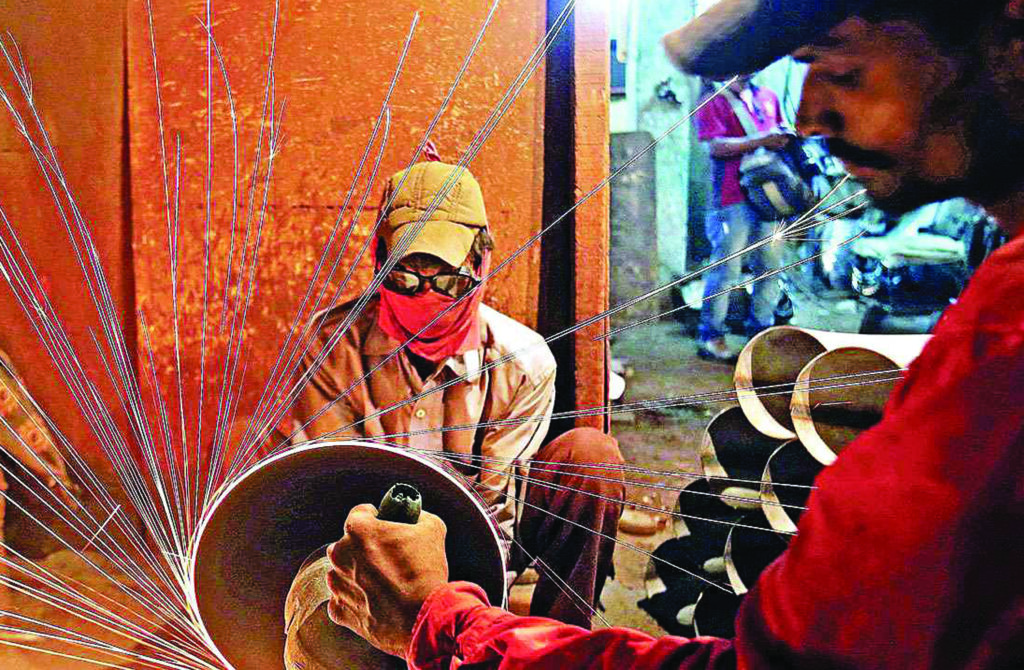“MSME advances–Root cause analysis of Poor Growth & Suggestions for Improvement”
Executive Summary
The Micro, Small & Medium Enterprises (MSME) sector is expected to play a major role in the emergence of the Indian economy. The growth of this segment is extremely crucial to meet the national aspiration of financial inclusion and generation of significant levels of employment across urban, semi urban and rural areas across the country. Further, it can rear and support development of new age entrepreneurs who have the potential to create globally competitive businesses from India. Time and again, Government has given importance to develop this sector by giving all types of helps i.e. technical and financial. Technical part is being looked after by various Government department and advance part is being looked after by Banks, mainly Public Sector Bank.
However, The Government of India is at crossroads these days. On one hand, the projects to augment MSME growth are focused around providing clean access to finance. On the other hand, banks are facing rising trend of stress in MSME. Though, time and again relief has been given to accelerate this sector but this is not a permanent solution. Hence, we have to analyse basic root cause to augment suitable measures by plugging the gap for a sustained growth of MSME sector.
Challenges Faced by MSME Sector Leading to Stress build-up
Credit Gap in MSME Sector-Credit exposure to MSMEs increased by 12% to ₹15.7 trillion in June 2019 (from ₹14 trillion in June 2018), according to data from TransUnion CIBIL, a credit information company, and Small Industries Development Bank of India (SIDBI). But this still falls significantly short of the total credit requirement in the sector. According to a 2018 study, the MSME sector has a credit gap of around ₹26 trillion with 90% of this gap felt by micro and small enterprises. The gap in debt can be largely attributed to underserved micro and small enterprises. In fact, demand from micro and small enterprises, respectively, constitutes 32 percent and 59 percent of the overall addressable credit demand. Yet, almost 75 percent of the addressable credit demand from micro enterprises and 80 percent of the addressable credit demand from small enterprises is currently unmet by formal financial sources. And as a share of total bank credit extended in the economy, credit to MSMEs has dried up. In March 2010, 17.3% of total bank credit was deployed to MSMEs but in March 2019 this had shrunk to 13.6%. To make up for the shortfall, MSMEs resort to informal channels of credit which come with a significantly higher cost of capital.
Differences in Geography of Operation-The states in India are split into three broad regions:
- Low Income States (LIS24) – Bihar, Chhattisgarh, Jharkhand, Madhya Pradesh, Orissa, Rajasthan, Uttar Pradesh, West Bengal
- North eastern States (NES) – Assam, Arunachal Pradesh, Nagaland, Manipur, Meghalaya, Mizoram, Tripura
- Rest of India – All states other than Low Income States and North eastern States.
There are significant geographical variations in India that have an impact on the distribution of micro, small and medium enterprises. The type of MSME, industries based in the region, and scale of operations also varies based on differences in the availability of natural resources and other regional characteristics, such as infrastructure, nature of local government incentives, access to markets, and education levels also dictate the type and scale of MSME activity in the region. Consequently the size and nature of finance demand and supply by MSMEs tends to vary with geography.

MSME Landscape in India-Just about 15 percent of the businesses in the sector are registered enterprises, although in order to encourage registration, the Ministry of Micro, Small and Medium Enterprises has simplified the registration process, replacing the earlier two-stage registration process with a one-step filling of memorandum.
Differences in Ownership Structure of MSMEs-The MSME Census data from 2007 indicate five specific types of ownership structures. Most small and medium enterprises that are well established or in knowledge-based service industry sectors are structured as private limited or public limited companies. However, 93.83% of MSME borrowers i.e. the borrowers under proprietorship, lack the skill of formal account maintenance, record maintenance, data management etc. They do not have the financial ability to hire professionals for record maintenance. They lack the ability to present their business reports as per banks requirement. Bankers on the other hand remain- indecisive as they do not get the required papers to take a call regarding the loan request.
Information Asymmetry-The MSME lending landscape is undergoing paradigm shift. Digitalisation, formalisation and Government initiatives are changing the lending pattern in MSME sector. This has created a large gap in the information available on the lending processes and enterprises are overwhelmingly unaware of how to procure a loan. Many times, they also are unable to meet documentation protocols to qualify as loan applicants to financial institutions. Not just that, MSMEs often seem to have discrepancies between their reported financial data and the actual state of financial affairs. Due to transactions, the reported data of micro enterprises in particular is often different from actual sales and profitability figures. In a lot of cases, these differences arise due to the inability to document transactions when there is a large volume of small-ticket transactions in cash. The problem is common for small and medium enterprises too due to the lack of organized and formalized book keeping systems. This effectively results in enterprises qualifying for much smaller what is needed.
Inadequate collateral-Micro and early- stage small enterprises typically do not have adequate access to immovable collateral that meets the criteria of financial institutions. This increases the credit risk perception of MSMEs. While banks and most NBFCs continue to insist on collateral requirement, MSMEs overwhelmingly prefer a loan option that does not require collateral when given the choice.
Limited equity base-On account of their inadequate equity base, MSMEs often take loans from multiple lenders, overextending themselves financially and making them vulnerable to defaulting. Additionally, these enterprises also access credit from informal sources, which are not reported to credit bureaus. Hence, financial institutions continue to err on the side of caution and are discouraged from providing debt finance to MSMEs.
Competition from multinational companies– In present era of globalization, the MSME`S are facing the great competition from the international manufacturing companies who are proving quality goods at cheapest price. Therefore, it is very difficult to compete with the multinational companies.
Poor infrastructure- Though, MSME`S are developing so rapidly but their infrastructure is very poor. With poor infrastructure, their production capacity is very low while production cost is very high.
Unavailability of raw material and other inputs- For MSME’s required raw material skilled work force and other inputs, which are not available in the market. Due to unavailability of these essentials, it is very difficult to produce the products at affordable prices.
Lack of distribution of marketing channels- The MSME`S are not adopting the innovative channels of marketing. Their advertisement and sales promotion are comparatively weaker than the multinational companies are. The ineffective advertisement and poor marketing channels leads to a very poor selling.

Rising Stress/NPA Ratios across MSE and Overall Portfolios of SCBs-
According to data from TransUnion CIBIL, NPA rates across the MSME sector spiked in the quarter ending June 2019. Among firms with credit exposure of less than a crore, the NPA rate jumped to 8.7% from 8.1% in the previous quarter. The NPA problem, though, increases with the size of the loan disbursed. Firms in the bigger credit exposure segment (exceeding ₹25 crore) have NPA rates of around 18%. Though private sector banks and non-banking financial companies (NBFCs) increasingly account for a greater share of the credit to MSMEs, the biggest formal credit source for MSMEs remain public sector banks (PSBs). As of June 2019, nearly half of all credit disbursed to MSMEs came from PSBs and these are the banks most vulnerable to MSME-related NPAs. In the June 2019 quarter, 16% of all PSB MSME credit was NPAs (up from 14.5% in the same quarter in June 2017) nearly three times the rates in private banks and NBFCs. Within MSMEs, some industries are suffering more. According to the TransUnion CIBIL report, the textile sector and the construction sector have the highest MSMEs NPA rates, while the auto industry is relatively less affected.
Reasons of Stress/NPA in MSME sector: There are several reasons of stress build-up in MSME sector:
Accidents/Natural calamities: A natural disaster is a major adverse event resulting from natural processes of the Earth; examples are floods, hurricanes, tornadoes, volcanic eruptions, earthquakes, tsunamis, storms, and other geologic processes. MSME sector is one of the affected. Southern part of India had witnessed natural calamities being on seashore as flood, tsunami etc.
Change in Govt. & its Policy: India is a Republic country and each Govt. has its own agenda. Eventually Policies and rules have been framed or changed by each government; these changes are directly or indirectly impact on the business houses. For example, Ban of particular items for export or import from any country, Increase of Taxes, Demonetization etc. Our interaction and on the above, it reveals that overall business has impacted a lot due to change of government and hence account turns to NPA.
Lack of effective Monitoring: In various audit and Vigilance cases in PSB, it is observed that in most of the NPA/Frauds accounts, post inspection either has not been done or if done then with casual approach. Had the Monitoring done properly, the account could have been saved.
Inappropriate technology: Technology needs to be upgraded. Further, it is observed that a person is availing loans from different banks/branches with same documents. Hence, Technology may be upgraded so that he cannot cheat the bank.
Industrial sickness: Industrial Sickness is one of the most affected root causes for NPA for MSME sector and recently this is nearly increased by 27%.
Reasons for large slippages-
- Poor / ineffective monitoring especially in accounts up to Rs.10.00 lacs.
- Non adherence to sanction terms & conditions.
- Unjustified and continuous excesses / ad-hoc sanctions.
- Non inspection of prime securities at regular intervals.
- Failure to identify early warning signals at the right time and take remedial measures.
- Failure in due diligence (especially new / taken over accounts).
- Business failures and other external reasons.
- Willful default
Challenges to Banks/FIs- The Banks/financial institutions face severe challenges that limit their ability to provide financing solutions to MSMEs:
High transaction cost and lower margins-For banks and NBFCs, financing MSMEs is both an expensive and a high-risk proposition. Constantly monitoring and engaging with MSMEs monitoring and engaging with MSMEs is considered too high a cost of business. The average size of credit extended by formal financial institutions based on assessed repayment capacity is even lower. On account of factors such as smaller ticket size, high cost of due diligence and collections, the profit margin from MSME loans is generally low, especially for traditional financial institutions. These are therefore inherent challenges for these institutions from pursuing MSME accounts actively.
Low-risk appetite-Financial institutions typically perceive MSMEs as a high-risk segment on account of their incomplete understanding of MSME businesses. Given their limited operations and resources, when banks do invest in providing loans to enterprises, they prefer to work with medium enterprises. That is because these businesses have more stable cash flows, formalized operational processes, and adequate collateral, affording a greater margin of safety and less resource-intensive due diligence to understand their business model. Risk aversion is topmost concern in the case of Public Sector banks due to the prospect of officers facing investigation from the Central Vigilance Commission and Central Bureau of Investigation when loans go bad.
Conservative Underwriting Process-The issue of higher risk aversion in the case of MSME loans, especially loans to micro and small enterprises, is further exacerbated by conservative credit evaluation that places too much emphasis on collateral and do not truly paint an effective picture on a borrower’s ability to repay a loan. Because many financial institutions do not spend adequate time on the ground with MSMEs, understanding their business models and monitoring their performance, traditional lenders are unable to create loan underwriting systems that are more relevant to MSMEs. In most cases, institutions rely more on evaluation parameters that focus on past performance of the enterprise rather than future opportunities.
Lack of Product Innovation-Traditional lenders continues to lack understanding of the MSME sector, and, therefore, they have not changed their approach to lending. They still rely on loan products that often seem misaligned to the needs and capabilities of MSMEs. Their loan products require specific types of immovable collateral, and are inflexible in terms of their tenure and payment structure, forcing MSMEs to seek finance through other avenues. A grassroots approach to developing novel methods to serve MSMEs with debt finance is necessary for banks and other institutions in order to advance the growth of the sector.
Suggestions for Improvements
Financial literacy-The major constraint of MSMEs is lack of financial knowledge. They do not maintain proper books of accounts. MSMEs can’t afford to employ accounting experts. They are dependent on outside Financial Consultants which is again a heavy cost factor to them. The Financial statements are prepared to avoid or save taxes. The real and clear picture of performance of MSMEs is not reflected. It is utmost important to make MSMEs financial literate in order to have easy credit access from Banks. Transparency of balance sheet will improve the willingness amongst Bankers to lend to this sector.
Training and development, awareness programs-There must be conduction of training and development programs by the MSME ministry. The currently running programs are not so effective and sufficient. One of the important reasons for slow intake in the utilization of schemes is the lack of knowledge about schemes and their likely benefits. The current knowledge dissemination system is limited in its outreach. There is a need to develop a better communication strategy and use of new age media tools.
Common application-A common loan application for MSMEs has to be designed and circulated to All Banks. It has to be a simplified and easily understandable to the MSME entrepreneurs. It should be made available at all web sites of all stake holders involved in MSME finance and Development
Transparency–MSMEs have to be allowed to know at what stage their loan application is and what are the factors hampering their rating and worthiness. Disclosure of appraisal system would be helpful for better financial discipline of MSMEs that leads to improved credit access.
Special loan products-There are thousands of clusters in the country. Almost all the MSMEs in the particular cluster have business similarities. i.e. supply chain, Markets, Technological issues, Man power etc. The key constraint to these Enterprises is delayed payments from the big Industries and Government Departments. Designing a loan product for specific clusters (i.e. Pharma cluster in Hyderabad, Auto components cluster in Indore, Readymade Garments, and Bangalore etc.) would address the specific problems of the local Enterprises. The loan product has to be designed based on constrains faced by them taking in to account their temporary liquidity crunches, Quality improvement programs, Energy saving and green initiatives.
Proper research and development-There should proper research and development in respect of innovative method of production and service rendering. The innovative products will provide the cheaper products and the SMEs will be able to cope up with the situation.
Lending skills-Often it has been seen that Bank officers have fear psychosis to lend to this sector on account of low compliances and defaults. Commercial Banks need to improve the skill of credit officers to assess the MSME proposal. Knowledge and skill will enhance the confidence levels of officers. This will change the attitude of the Bank officers. Bank Authorities also have to create conducive environment for MSME lending.
Credit Counselling Cells-Bank should form credit counselling cells to counsel and advise the MSMEs to be able to submit Bankable proposals. The practice which is in place now is that MSMEs hire the services of Chartered Accountants who act as an Intermediary between Bank and MSMEs. CAs represents the Entrepreneurs while interacting with the Bank officials and convinces the Bank on the present and future Business plans. The cost of the Financial Consultants is also a burden on the MSMEs.
Constitution of a Panel of Consultants-For the purpose of technological advancement and guidance a panel of experts and consultants should be prepared, who can help the MSMEs within the region for effectively transfer the available technologies. The constitution of panel of these consultants could be nature wise of the activities of the MSME. At the time of constitution of panel of experts, there should be inclusion of the owners of different sectors of MSMEs.
Special Market teams-Banks have to form special teams to source the MSME proposals at specific locations. Formal sector Financing Agencies are still unreachable to the MSMEs which are in unorganized sector. Banks have to come to the field for a merit based successful Bank linkages.
Relaxation in labour laws and red tape-There should be relaxation in complex labour laws to avoid the inconvenience in compliance.
Regulatory-One “all India all-purpose” enactment as MSME regulation to be adopted by all stakeholders in MSME system with one window and one annual return compliance filing coupled with significant direct tax incentives and indirect tax exemptions.
Performance incentives–Direct incentives in form for direct taxes rebates and set offs, weighted deductions and reliefs in indirect taxes combined with low cost funding and credit access for stakeholders in MSME eco system who make investments in desired areas and achievement of desired growth results in developing MSME funding and infrastructure skills, technology, innovation, global market access, indigenization, public procurement and vendor development, traditional and heritage industry developments.
Rationalization of NPA norms–MSMEs face business uncertainties which are general factors in the business of that size. It could be because of delayed receivables or temporary liquidity crunches. Classification of NPA for default of three Months is not genuinely applicable to MSMEs. It should be 6 months or more.

Rehabilitation of viable sick units–There is a lot of scope for sick MSMEs for rehabilitation through further injection of funds in the business by the Banks other than interest concessions. The tendency shows that Banks do not undertake rehabilitation program on account of higher risks. A positive approach of banker will help thousands of sick MSMEs to take a turn around.
Budgetary Support (2020-21) & Initiatives by GOI-The importance of MSMEs is reiterated in all policy documents and is the latest budget (2019-2020) is no different:
Delay in Payments-The budget has attempted to fix the problem of delays in payments to MSMEs. The government has spoken of creating a payment platform for MSMEs to facilitate the billing and payments through it. This is in sync with the UK Sinha Committee recommendations on MSME reforms.
Psb59minuteloan-The extension of the 59-minute loan scheme to new entrepreneurs will fit well with the government’s emphasis on start-ups and MSME
Collateral Free Loan-The limit for collateral-free loans has been raised to ₹20 lakh from ₹10 lakh.
SIDBI Involvement-Institutional changes in SIDBI should be done so that it can be elevated as a market maker for funding of MSMEs. SIDBI should be involved in getting micro-finance institutions (MFIs) and non-banking finance companies (NBFCs) to finance MSMEs, and venture capital funds would be an integral part of the system that is linked to potential borrowers.
MUDRA-MUDRA should be reinvented so that SIDBI becomes more effective in its operations as it gets into underwriting, risk management and fund-raising on its own.
CGTMSE- To make lending effective, credit guarantee of loans to MSMEs is important. The UK Sinha panel stated that all these schemes should be regulated and brought under the RBI.
Relaxation in Regulatory Norms–The issue of a potential default is relevant for MSMEs as the class of entrepreneurs is different from those in the corporate sector and the size of the loan is much smaller. Hence, using the normal 180-day rule under Insolvency and bankruptcy code should be relaxed in case of MSME.
Infrastructure Development–For demand generation, augmentation of industrial infrastructure and promotion of MSMEs. Industrial corridors should address the lack of infrastructure and logistics.
Public Procurement Policy-The government can play a crucial role in creating domestic manufacturing capabilities by leveraging proposed public procurement and projects. Mega public projects such as Sagarmala, Bharatmala, industrial corridors, and the Pradhan Mantri Awas Yojana (PMAY) can stimulate domestic manufacturing activities provided the projects are suitably structured and demand is aggregated strategically.
Conclusion:
The global economy has entered a recession as a consequence of the coronavirus pandemic. There are lockdowns across the world, hitting economies hard. The International Monetary Fund (IMF) has said this recession will be worse than the one in 2009, caused by the global financial crisis. With its low dependence on exports and the advantage of moving early on social distancing, the Indian economy may do better than some other developing countries but same is not possible unless otherwise MSMEs are given priorities and they exist to take the advantage of global recession.
Moratorium on EMI payment for 3 months is not sufficient, instead Government must waive the interest at least for 6 months as being done in other affected countries.
Government must clear all pending dues including GST refunds to MSMEs at the earliest and all complaints for recovery should be resolved within 30 days from date of said complaint
Wage support could be made available to workers employed in such units, a Wage Subsidy to MSMEs, especially in the Manufacturing sector, to the extent of 50 per cent for all registered workers for a period of 6 months
All government concession should be provided only for those organisation or establishment which has 50 percent procurement from MSMEs and all Governments including Government Undertakings should procure their entire requirement from MSMEs only at market price on transparent basis.
Concessional Insurance premium must be charged for all non-life Insurance policies including workmen policies taken by all MSMEs for period of two years
Concessional power supply facilities should be given to all these MSMEs including waiver Electricity Duty for one year.
With the above mentioned support/relief from the GOI as well as prompt and suitable handholding from Banks & FIs, the MSME Sector can regain its lost ground and bounce back to accelerate their growth and also help in the growth of Indian economy.
Bibliography
- Reports on Credit disruption by Omidyar Network & BCG
- MSME schemes launched by the Government
- Annual Report 2017-18 of NIMSME
- Financing India’s MSME : IFC.org
- MSME pulse December 2020
- Indian Government’s major MSME Policy initiatives
- Key to MSME Growth: FICCI CMSME
- Micro, Small & Medium Enterprises: Vibrant Gujarat 2017
- MSME policies: Dr. Nalla Bala Kalyan
- MSME Report Jan’20: TransUnion CIBIL
Websites:

